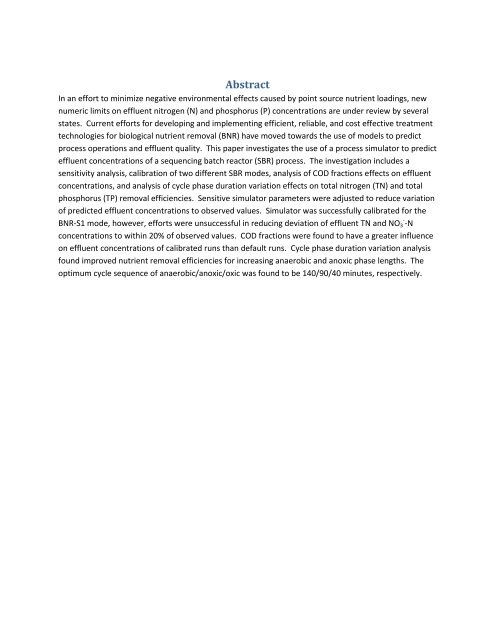E-Andrew Sindt Creative Component S11.pdf
E-Andrew Sindt Creative Component S11.pdf
E-Andrew Sindt Creative Component S11.pdf
You also want an ePaper? Increase the reach of your titles
YUMPU automatically turns print PDFs into web optimized ePapers that Google loves.
AbstractIn an effort to minimize negative environmental effects caused by point source nutrient loadings, newnumeric limits on effluent nitrogen (N) and phosphorus (P) concentrations are under review by severalstates. Current efforts for developing and implementing efficient, reliable, and cost effective treatmenttechnologies for biological nutrient removal (BNR) have moved towards the use of models to predictprocess operations and effluent quality. This paper investigates the use of a process simulator to predicteffluent concentrations of a sequencing batch reactor (SBR) process. The investigation includes asensitivity analysis, calibration of two different SBR modes, analysis of COD fractions effects on effluentconcentrations, and analysis of cycle phase duration variation effects on total nitrogen (TN) and totalphosphorus (TP) removal efficiencies. Sensitive simulator parameters were adjusted to reduce variationof predicted effluent concentrations to observed values. Simulator was successfully calibrated for theBNR-S1 mode, however, efforts were unsuccessful in reducing deviation of effluent TN and NO 3 - -Nconcentrations to within 20% of observed values. COD fractions were found to have a greater influenceon effluent concentrations of calibrated runs than default runs. Cycle phase duration variation analysisfound improved nutrient removal efficiencies for increasing anaerobic and anoxic phase lengths. Theoptimum cycle sequence of anaerobic/anoxic/oxic was found to be 140/90/40 minutes, respectively.
















